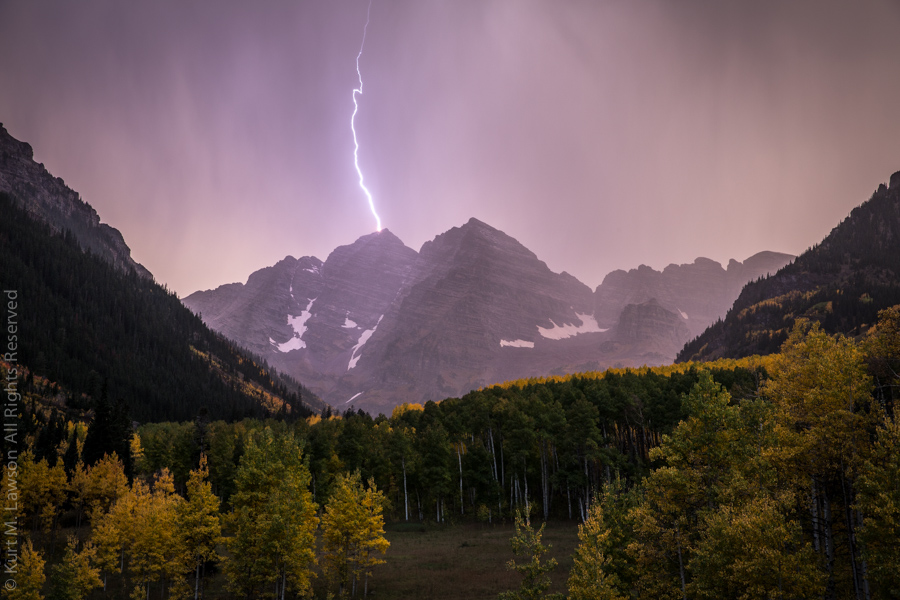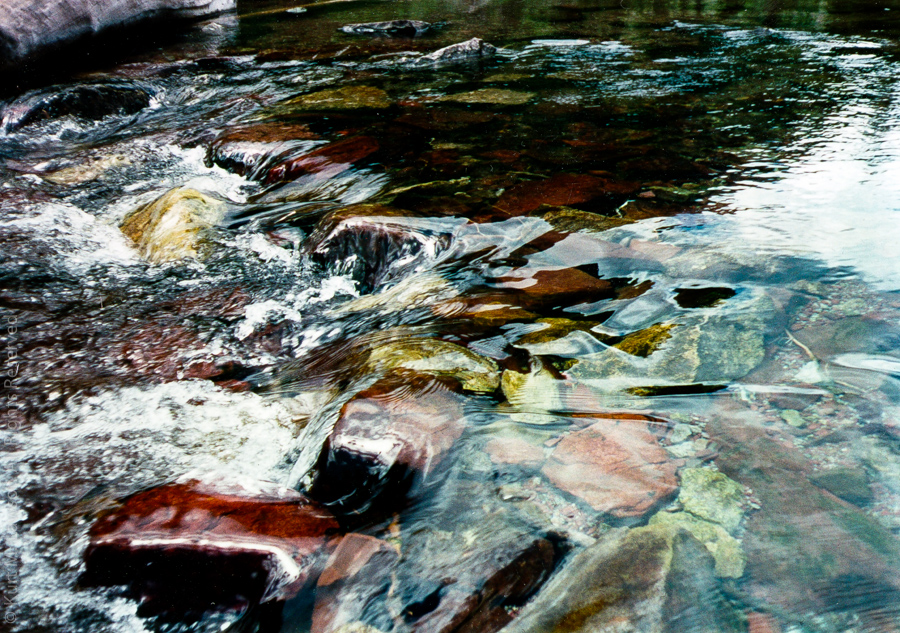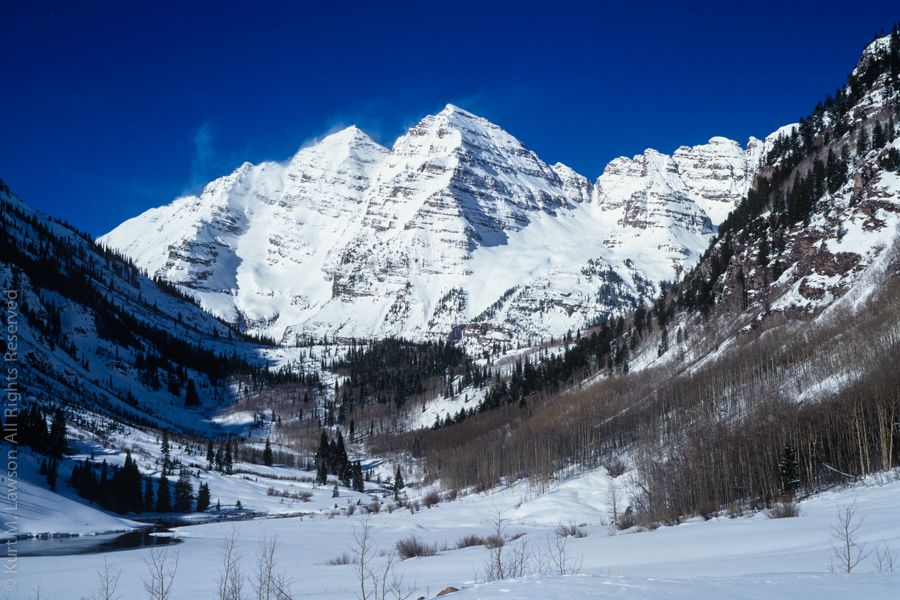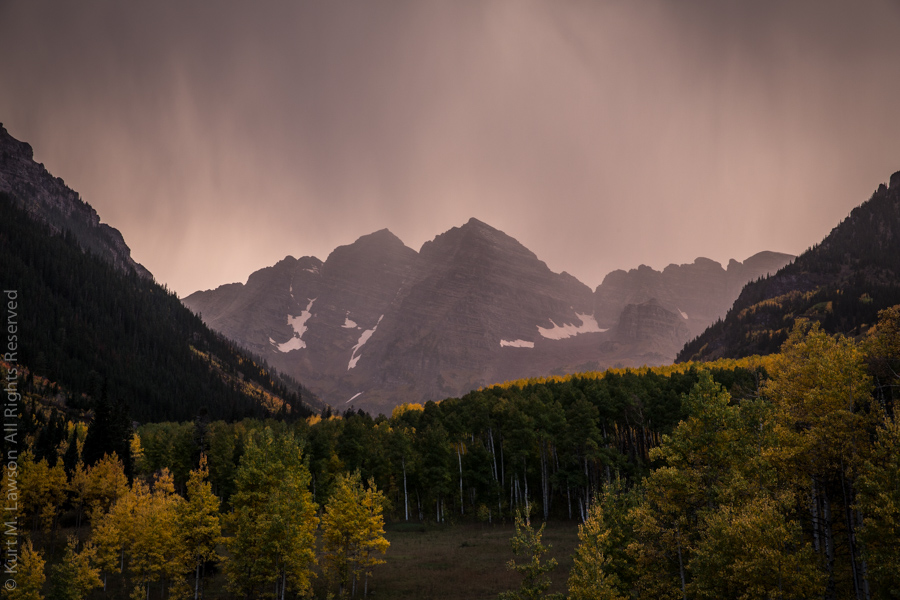
Lightning Strikes the Maroon Bells
The Maroon Bells. You’ve probably seen them before. These two 14’ers in the Rocky Mountains in Colorado near Aspen are amongst the most photographed peaks in the world. In warm months hundreds of people visit the Maroon Creek valley and gaze upon these oddly colored pointy summits framed up by picturesque valleys of quaking aspens and evergreens, with all reflected in Maroon Lake which seems to have been put there just for that purpose. So many people visit the Maroon Bells in fact that during the summer and in weekends in the fall private car traffic is restricted here and you must take a shuttle bus from 9am to 5pm. The US Forest Service does this because there’s just not enough parking for all the people that wish to go there. The White River National Forest manages the Maroon Bells Scenic Area, which is the gateway to the Maroon Bells – Snowmass Wilderness, which has excellent hiking and backpacking.
For me the you could say the Maroon Bells are the epicenter of an origin story: the origins of my own photographic roots. My family made a couple of family vacations to the Aspen Area when I was growing up. This is a place some 1300 miles away and terrain vastly different than the glacially flattened mountain-free land of the midwest. The last of these trips was in approximately 1989 or 1990. I was an energetic little 10 year old running around, and I had a little Vivitar point and shoot film camera in hand in this valley. Strangely, I don’t have much of a memory of the beautiful mountain peaks around. I was more interested in running around the meadows and exploring Maroon Creek’s clear waters. In my young wanderings, one photo seemed to catch the interest of my parents and others who later saw it. It was a photo of Maroon Creek flowing over its rocky bottom.

Maroon Creek, circa 1989
Being so many years ago memories are a bit fuzzy, but I do recall the praise that I received for this shot, and you might say that in some sense lightning struck on that day and ignited a photographic spark in my mind that would grow and develop for the rest of my life. By 1995 I was in high school. Elmhurst High School in Fort Wayne had a photography class – a class I would take for all 4 years. My photography teacher, Don Goss, had previously taught a few other neighborhood photographers that you might have heard of – Peter and David Turnley. I had a great time with my photography class then and received a lot of encouragement from Mr. Goss and others as I really embraced photography. Somehow by 1995 I had managed to acquire a Mamiya 645 Super camera even. In high school I was already a bit obsessed with getting more resolution than 35mm film had to offer, ha!
In spring of 1995, I traveled to Colorado with my Mom. This would be my first return trip to the Maroon Bells with my own professional photographic equipment and my new found passion for photography. I had my Mamiya 645 Super and 80mm 2.8 Lens, and for the very first time rented two additional lenses for the occasion – the 210mm F4 and the 45mm 2.8. We rented these from somewhere in Denver and then made our way west to Aspen. This was early spring and snow was everywhere. In fact, we discovered that the Maroon Bells had been closed for the winter due to avalanche danger, but we could check at the T-Lazy-7 Ranch to see about taking snowmobiles up there. We went to the Ranch, which is the end of where Maroon Creek Road is plowed of snow and learned that they had just checked the route and we could safely take snowmobiles up to the lake. So we suited up, rented machines, and headed up. They told us we were the first to do so that spring. For the entire time we were there it was just Mom and I and the silence of the snowy valley. It was very memorable.

Maroon Bells, Spring 1995
The Bells were gorgeous. I was captivated by them and also by the aspen trees. I loved photos I had seen of Aspen trees, and relished seeing them in person. I’ve always thought their bark had this seemingly magical way that the light seemed to wrap around their white trunks. When we were in Aspen we visited some art galleries. In at least one gallery there was the work of Christopher Burkett. This photo blew me away. The gallery had an enormous Cibachrome print and the golden trunks and white bark burned into my mind. A quest for my own similar shot would help fuel motivation for returning to Colorado in the fall years later. After spending the day by Maroon Lake in the valley of the Maroon Bells with just my Mom and myself, it was time to leave. I would not return for 19 years. Check out some more photos from this catalytic trip below.
Fast forward to 2014 and after years of dreaming of a fall color trip to Colorado, I decided that the time was now and I made it happen at last. On my second day of travel from southern California, I arrived at my campsite in Maroon Valley in the dark. With clear skies forecast for the next few days, I didn’t make an effort to get up super early to try to capture the sort of iconic Maroon Bells fall shot that many photographers chase. I did not expect to capture a unique view of this location. Instead I would try to get that sort of iconic Maroon Bells shot for myself and enjoy the area, exploring for aspen groves and mountain views that these eyes had never seen. Armed with my twin 5D3’s, a Sony A7r and a Mamiya 7 II film camera I was prepared for anything. My Nissan Xterra Pro 4x would take me wherever I needed. The color was peaking in many areas when I arrived, and the sights and smells of fall saturated my mind.

Fall Maroon Bells Sunrise
The way I figured, most photographers were chasing a sort of magic formula fall color sunrise shot at the Bells. You needed some snow to accent the peaks, no wind for a perfect reflection in the lake, peak fall color in the aspens and some clouds to capture dramatic color of the rising sun and add interest to the sky. In the photo above there is just one of those – peak color. To get a good spot at the lake, you had to arrive early. 5am early. By sunrise at 7am on one morning there were probably 100 other photographers along the lake, tripod to tripod. Did I mention at the beginning of this post that the Maroon Bells are possibly the most photographed peaks in North America? Generally most everyone was courteous to other photographers and it was nice to have some shop talk about photography as we all waited for the light. Some very nice photographers told me of other places to visit in the area and on this solitary trip it was great to have a little like-minded photographic company. All told I spent 4 mornings along the lake, watching the grand light show play out. Three of those mornings had zero clouds. The final day had perhaps too much clouds. The final morning I brought out the Mamiya 7 II to capture a film image of the Bells, connecting back to my trip with the Mamiya 645 19 years before. I pressed the shutter during a fleeing window of sunlight filtering through the stormy skies onto the ridge. The Fuji Provia 100 film provided a purplish rendering of the cloudy morning light.

Purple Mountains Majesty
As I mentioned the trip was more than just about the Bells. I was after a Christpher Burkett inspired aspen grove. Each day I would explore new roads in the surrounding areas and discover a new stand of trees I felt was more amazing than the last. Here is a shot looking straight up in a grove just right along the Maroon Creek road.

Aspen Canopy
And another taken literally on the side of the road.

Morning Aspen Light
My biggest surprise however I would not discover until after I returned home to California. After a few cloudless days at the Bells some weather rolled in around sunset. Although not famous for being a sunset location, I decided to hang out in Maroon Valley as a storm rolled in. I knew that eventually some weather would arrive during my trip and shortly after I arrived I thought that the only way I would capture a truly unique view of the Bells would be to capture lightning hitting them in a storm. This is a risky proposition for obvious reasons, and the weather in the mountains is hard to predict. Since last summer, I have owned a Lightning Trigger LT-IV. In my 9066 mile road trip last summer I managed to capture two shots that included bolts. I’ve done night time lightning shots before, but to capture daytime shots is really hard. That’s where the trigger comes in. Using an infrared sensor it will trigger the shutter as fast as possible. Because most bolts are actually multiple strikes along the same path, it gives you a chance (certainly no guarantee!) that you might capture something.

Stormy Maroon Sunset
Above is a shot of the storm as it came in through Sunset. I figured I had a chance, so I set up a 5D3 with the lightning trigger, 24-70mm 2.8L II zoom lens, and a hope. I set up the composition and then set about taking photos of the sunset with the Sony A7r. There wasn’t much hope. The storm wasn’t producing much of any thunder. I didn’t see a single bolt all sunset, and heard thunder maybe 4 or 5 times total only one of which caused me a little alarm. I was standing rather exposed in a meadow so I was very mindful of any sound that could be thunder and how close it might be. I shot photos through sunset and returned to the 5D3. I saw that the trigger had gone off, but in my quick look at the tiny LCD on the back of the camera and I didn’t notice a bolt. Three frames were triggered over the course of about a second, and at the time I thought that singular trigger event had produced nothing. This was the only shot I had at lightning for the whole trip, and I thought I had come up empty. I did not encounter a thunderstorm again this trip. Days later when I returned home however, I was in for a shock (no pun intended). When I downloaded all my RAW files (more then 400GB of them), I eventually got to the trio of frames spurred by the trigger. And there it was. A single, glorious direct hit on Maroon Peak. I was floored. I still can’t believe my luck. After so few hints of thunder during that storm, I can’t believe I captured this bolt. I didn’t even witness it with my own eyes. I was either looking away or blinked or whatever, and I didn’t notice it in my tiny LCD monitor on the camera. Unlike previous road trips I generally didn’t look through the day’s shots on the LCD in detail at the end of each day, so I never noticed until I was back. Watch a slideshow below of two images captured less than a second apart:
You can really see how the lightning was backlighting the bands of rain. The sun had set by this time, so the light was fading but was still full of warm sunset colors scattered by the clouds. In fact, you can do something really cool when you have two shots like this. If you think about it, the lightning is adding to the scene. It’s a light source in the otherwise dark Maroon Bells scene. So, I can take the image with the lightning and the image without lightning and do something really cool with a compositing program like Photoshop. These images were both processed in Lightroom, which I use for 99% of anything I ever do with any of my photographs. You can read about my philosophy about compositing in photographs in this blog post from awhile back. Anyway, with Photoshop you can see just what exactly the difference is between lightning and no lightning by subtracting (blending mode) the non-lightning image from the lightning image. The result is actually really cool. You can see what is brighter in the lightning image vs the non-lightning image. Essentially, this is just the lightning and its influence in the scene. The darker image pixels RGB values are subtracted from the brighter lightning image so you just see the difference.

Just the lightning
To make it easier to see I used a Levels control to brighten the result, but it’s just something neat to see. The bolt is striking just off of Maroon Peak. The left hand peak is the higher of the two, appearing shorter in frame due to perspective. Maroon Peak is 14,163 feet above sea level and North Maroon peak on the right is 14,019 feet. With that knowledge I’m guessing the bolt hit above the 14,000 ft line, just south of the summit. Here’s a 100% crop of the striking point stopped down. I sure wouldn’t want to be on the peak during a storm!

100% Crop of the Strike
I’ve been back for a few weeks now from Colorado and the state is still on my mind. What an amazing place! I can’t believe it had been 19 years since I had been back to the Maroon Bells. I promise the next time will not be 19 years from now! I can’t believe my luck in capturing the lightning strike on the Bells. I’ve done some Google searching and I have not yet found a photo by anyone else of a bolt striking those famous peaks, though I’m sure especially in the summertime it’s not a rare thing. Figuratively lightning struck me at the Maroon Bells all those years ago, providing a catalyst for my photographic exploration. On my return visit I literally captured lightning in my camera.
I hope you’ve enjoyed reading my little photographic origin story. I have many, many more photos from the trip I’ll be posting in the coming days. Keep up with my most recent shots on flickr, 500px, Google+, or Facebook.















by Kurt